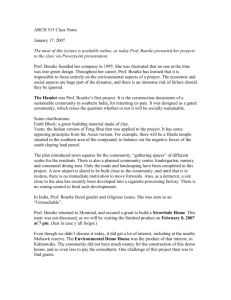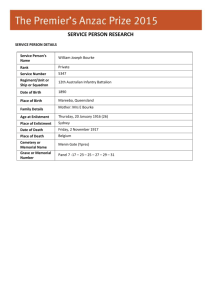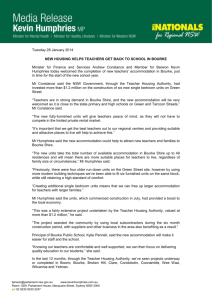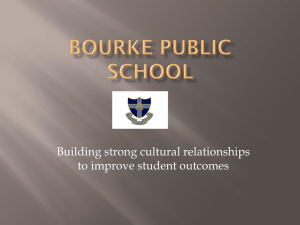bourgeois order. Ultimately, though, by ... obsolete the Pan-German League was in the Weimar Republic, these...
advertisement
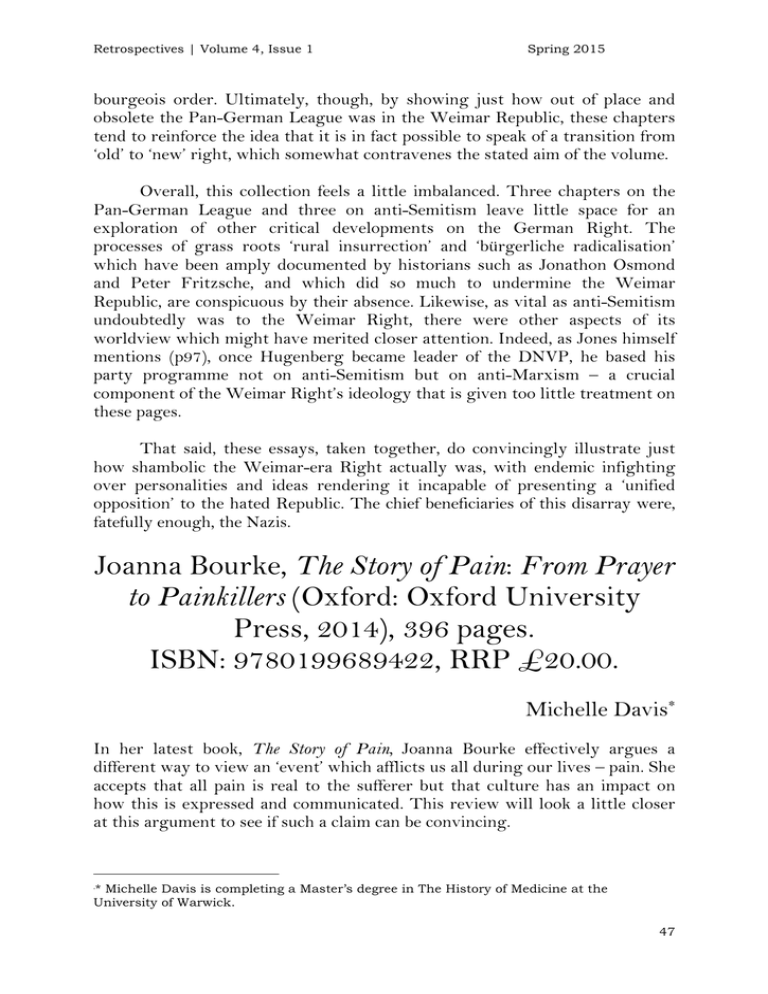
Retrospectives | Volume 4, Issue 1 Spring 2015 ! ! bourgeois order. Ultimately, though, by showing just how out of place and obsolete the Pan-German League was in the Weimar Republic, these chapters tend to reinforce the idea that it is in fact possible to speak of a transition from ‘old’ to ‘new’ right, which somewhat contravenes the stated aim of the volume. Overall, this collection feels a little imbalanced. Three chapters on the Pan-German League and three on anti-Semitism leave little space for an exploration of other critical developments on the German Right. The processes of grass roots ‘rural insurrection’ and ‘bürgerliche radicalisation’ which have been amply documented by historians such as Jonathon Osmond and Peter Fritzsche, and which did so much to undermine the Weimar Republic, are conspicuous by their absence. Likewise, as vital as anti-Semitism undoubtedly was to the Weimar Right, there were other aspects of its worldview which might have merited closer attention. Indeed, as Jones himself mentions (p97), once Hugenberg became leader of the DNVP, he based his party programme not on anti-Semitism but on anti-Marxism – a crucial component of the Weimar Right’s ideology that is given too little treatment on these pages. That said, these essays, taken together, do convincingly illustrate just how shambolic the Weimar-era Right actually was, with endemic infighting over personalities and ideas rendering it incapable of presenting a ‘unified opposition’ to the hated Republic. The chief beneficiaries of this disarray were, fatefully enough, the Nazis. Joanna Bourke, The Story of Pain: From Prayer to Painkillers (Oxford: Oxford University Press, 2014), 396 pages. ISBN: 9780199689422, RRP £20.00. Michelle Davis∗ In her latest book, The Story of Pain, Joanna Bourke effectively argues a different way to view an ‘event’ which afflicts us all during our lives – pain. She accepts that all pain is real to the sufferer but that culture has an impact on how this is expressed and communicated. This review will look a little closer at this argument to see if such a claim can be convincing. !!!!!!!!!!!!!!!!!!!!!!!!!!!!!!!!!!!!!!!!!!!!!!!!!!!!!!!! * Michelle Davis is completing a Master’s degree in The History of Medicine at the University of Warwick. ∗ 47 Retrospectives | Volume 4, Issue 1 Spring 2015 ! ! The Story of Pain is a refreshing read which certainly adds value to this area of historical research. Bourke states the most influential text on pain from recent times is Elaine Scarry’s The Body of Pain published in 1985 (4). She also suggests, however, that Scarry falls into a trap by writing of pain as an entity and thus Bourke has claimed that Scarry cannot express the changing social environment that surrounds it due to its individualism (5). Bourke argues that this trap results in the viewpoint that pain has a limited historical investigation, which she then proceeds to argue against. Through introducing her methodology of removing the agency from pain, Bourke allows the reader to see pain as a type of event constructed by society, and not just as a biological entity. This allows the changes in language to be assessed because pain is not questioned, but the way in which pain is communicated to others around the sufferer can be. Each chapter of The Story of Pain has a different theme but all centre on the idea of changing language. Within the first half of the book Bourke explores how pain is expressed to others using metaphors and similes. Her findings are very fruitful. The development of using metaphors as signals of pain is demonstrated particularly well in the chapters titled Metaphor and Religion, for example Bourke picks up on an early twentieth century trend of comparing other pain to toothache; ‘my leg has toothache’ (56) a World War One amputee complained; ‘toothache in my back’ (56) stated a steam trawler worker. These contrast very well with the following chapter on diagnosis. Here Bourke argues that whilst language developed amongst peers with the metaphors aforementioned for example, it diminished in the doctor-patient relationship. This is demonstrated by using textbooks for medical students which described the patient’s narrative as ‘contributing little to the process of identifying disease’ (136). Furthermore, Bourke uses class as one of many factors to demonstrate the multiple coexisting experiences of pain, stating that by the end of the nineteenth century and throughout the twentieth, a doctor’s relationship with his patient depended on how rich the latter was and that only the richest of sufferers received the time to voice their story of pain (134-136). By combining these trends Bourke shows that pain had a more multifaceted trajectory through time, enabling her to make a case for pain being a construction of the social environment. The Story of Pain is undoubtedly at its strongest and most interesting when it is suggested that being in pain could alter the definition of being human. It is a theme which appears throughout the book but prominently in the chapter titled Estrangement. Bourke draws on multiple examples from the nineteenth century to demonstrate the idea that behaving in pain was to lose humanity. These examples, like ‘writhing like a wounded animal’ (41), show that to behave in pain was akin to behaving like a lower being – an animal in 48 Retrospectives | Volume 4, Issue 1 Spring 2015 ! ! this case. Yet, whilst the trend in analogising pain is important, analysis on why animals specifically are used is lacking in Bourke’s analysis. The estrangement of the sufferer is explained but the reason behind the language employed, which places people as others, lacks depth. This is surprising considering that Bourke has previously written on this topic, so many readers would expect the incorporation of this material into her new work.1 Instead, in this chapter at least, Bourke uses the source material only to demonstrate changes in the way pain was expressed, and the impact it had on the sufferer. She does not offer an explanation of how the metaphor was constructed. Thus, whilst Bourke does move the debate forward on pain by opening up this idea that pain is not all the same, and her argument on language is interesting, the book fails to do more than show that this area deserves to be studied. I do not, however, want to discourage anyone from reading The Story of Pain; it has been written as a foundation to help develop new ways of thinking about ourselves and our sorrows (xi). Bourke has successfully demonstrated that pain should be seen more as an event which shifts and changes depending on the social environment and century – certainly the experience is very different since the arrival of painkillers and anaesthetics. Bourke’s study achieves its goal of opening pain up as a serious line of academic enquiry, but it is a book that leaves you asking for more. Nicholas Grene, Nothing Quite Like It: An American – Irish Childhood (Dromore: Somerville Press, 2011). 176 pages. ISBN: 9780956223159, RRP £11.99. Yuh J. Hwang* Nicholas Grene’s memoir, Nothing Quite Like It recollects the author’s childhood in Ireland as ‘an Anglo-Irish, American, Polish Jew’ (9). The work comprises nineteen chapters, ranging from ‘Prehistory’ (referring to the author’s family) to ‘Going up to Trinity’ in the 1950s. It recounts how a little boy he had grown up and built his own world in opposition to external reality, in which he had to face a ‘Clash-limited perspective’ (38) - Clash being the name of the small village in which the author was raised and lived for almost sixty years. The book explores his school days in the local Protestant National !!!!!!!!!!!!!!!!!!!!!!!!!!!!!!!!!!!!!!!!!!!!!!!!!!!!!!!! Bourke, Joanna, What it Means to be Human: Reflections from 1791 to the Present, (London: Virago, 2011). * Yuh J. Hwang is completing a PhD in the Drama department at Trinity College Dublin. 1 49
